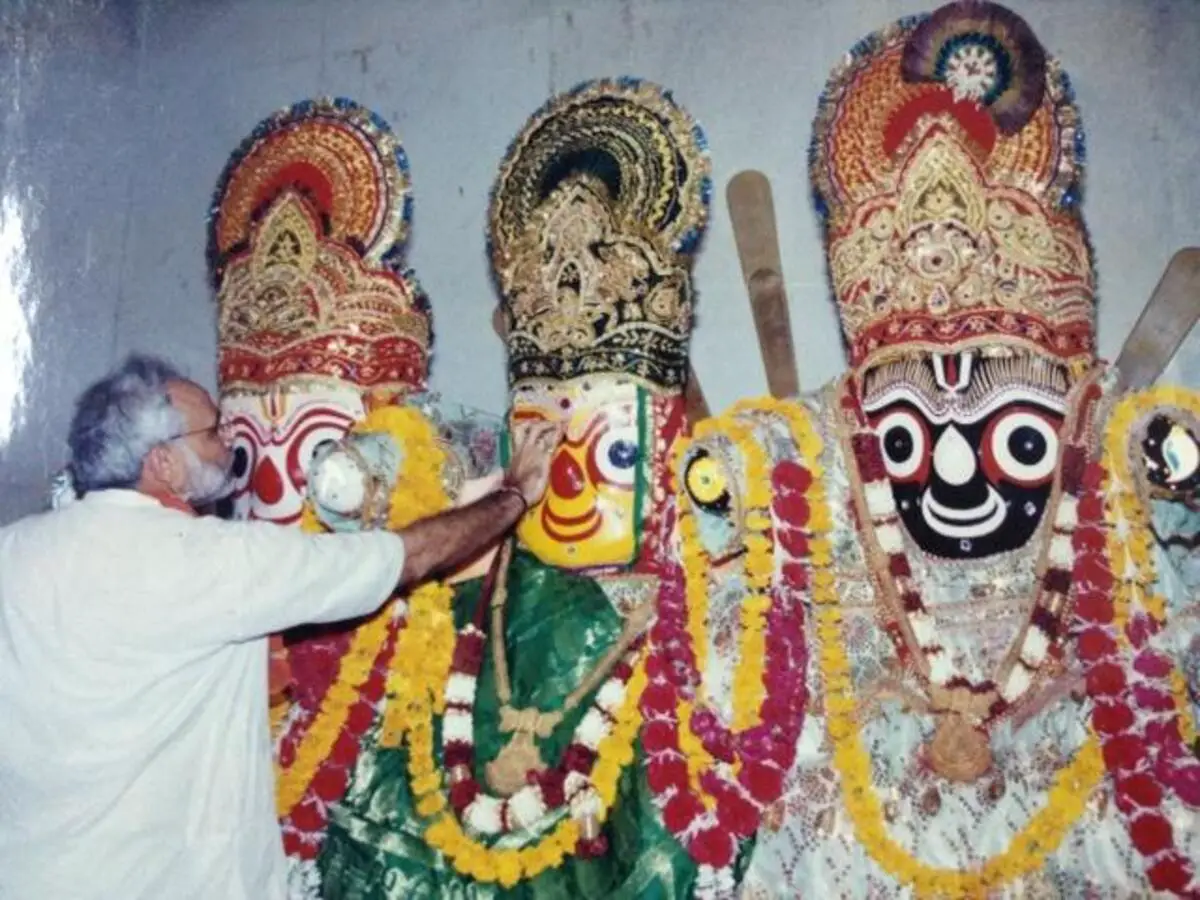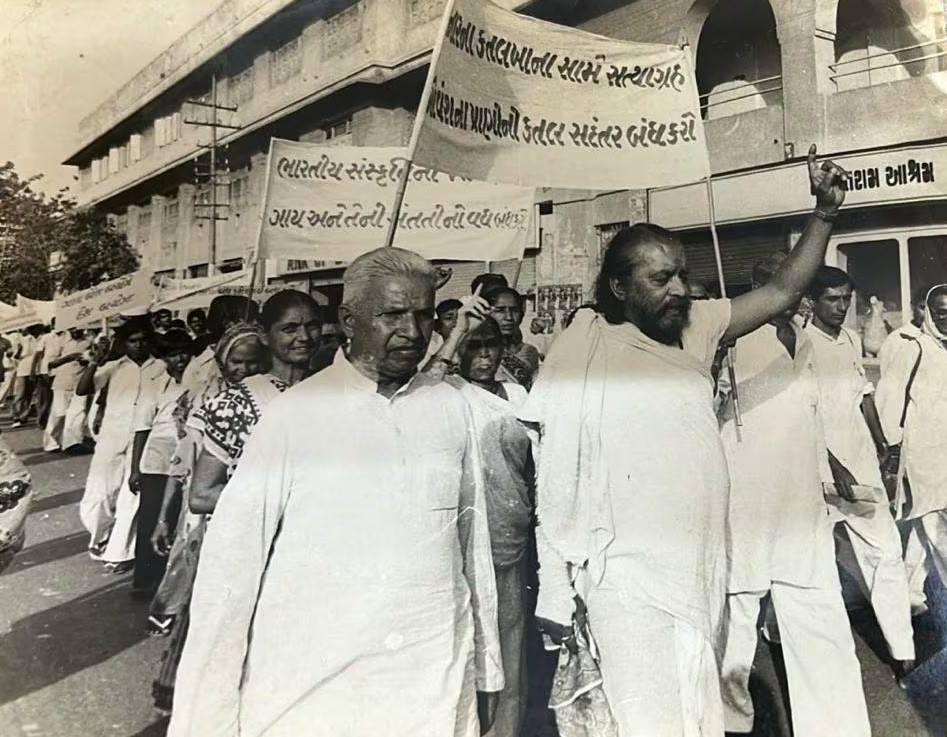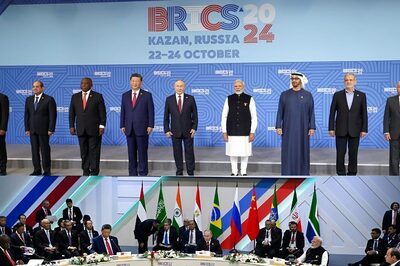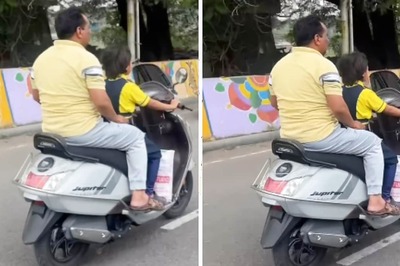
views
Before Narendra Modi came to Ahmedabad in 1969, the Vishva Hindu Parishad had decided to open its office in a building attached to the Jagannath temple. First, the rent here was not high, and second, the then mahant of the temple and the person who took over the reins after him also gave full support to VHP activities. This building of the Jagannath Temple Trust was right in front of the main door of the temple. Every person visiting the temple could be seen from the Parishad office and met swiftly.
It was also convenient for the workers to reach this office in the Jamalpur area of the city. Besides doing the work of the parishad, they also had the opportunity to have darshan of Lord Jagannath. The VHP’s office was in two rooms on the first floor of the building, while there was a shop, named Bharat Cycle, downstairs. The shop was run by two Sindhi brothers. It made things easier for the cadres too when their bicycles needed repairs.
When Narendra Modi arrived here as a 19-year-old, the area surrounding the temple was sparsely populated. The eastern bank of the Sabarmati river was just beside the temple complex. Back then, most of the population of the city used to reside in the eastern part, which was known as the Walled City or Kot Vistar.
If walls could talk…
Ahmedabad was surrounded by walls during the Sultanate period, and entry and exit required passing through gates. At night, the gates remained shut. Later, as the population grew, these walls began to collapse, and people started settling outside the Kot Vistar as well as in the areas closer to the Sabarmati river’s western bank. Most of the gates though remained intact.
The temple of Lord Jagannath near the eastern bank of the Sabarmati river was just outside one such historical gate, named the Jamalpur Darwaza. It was often referred to by devotees as the Jagdish temple, and this name was written on its doors at various locations. The temple was a significant place of worship for the city’s Hindu population and used to witness gatherings of saints and sages at the time. Sadhus and sanyasis used to come here not only from different parts of Gujarat but also from other parts of the country. The heads of two famous akharas also used to live in the temple premises.

The temple area was located outside Kot Vistar and was surrounded by dense forests around 300 years ago. At the time, this place was ideal for sadhus and sanyasis. They could do sadhana (meditation) comfortably in the forest and take a bath in the sacred waters of the Sabarmati river.
It was during those days when a sadhu, famous as Hanumandas Maharaj, had come there. He used to worship Lord Hanuman, the biggest devotee of Lord Ram. Hindu devotees from surrounding areas had started coming in large numbers to worship Lord Hanuman there.
The temple followed the guru-shishya tradition. Sarangdasji had become the successor of Hanumandas Maharaj. Sarangdasji was an ardent devotee of Lord Jagannath and often used to visit Puri for the Yatra. It is said that during one such visit, when he was in Puri, Lord Jagannath appeared in Sarangdasji’s dream and asked that his idol along with those of his sister Subhadra and brother Balram be installed in Ahmedabad.
Later, the idol of Lord Jagannath, along with those of his brother and sister, was installed in the Hanuman temple with great fanfare and people started worshipping them. The temple later became famous as Jagannath Temple. After Sarangdasji, Balmukundasji became the mahant of the temple. His successor was Narsinghdasji.
In the service of cows
It was during the time of Narsinghdasji that this temple carved its place in the hearts of the people of Gujarat, including Ahmedabad. During his time, not only was the temple renovated but a cowshed was also built to provide shelter to hundreds of cows. Sadavrat (serving food) became a common practice in the temple. Be it a sadhu-sanyasi or a common man, nobody left the place with an empty stomach. Milk, curd, buttermilk, and kheer used to be served there. During times of drought, the temple used to provide ample help, from grass and fodder for cattle to food for the people.
Narsinghdasji was the mahant of the temple even before Independence. The officers used to respect him even during the British era. His personality was quite charismatic. It is said that during the British Raj when officials seized the grains kept in the temple premises and tried to remove them, they failed. He was also made the Mahamandaleshwar by the Sadhu Samaj during the Mahakumbh of Prayag in 1957. After he took samadhi, Sevadasji took over as the mahant of the temple.
In 1969, Sevadasji was the mahant of the temple when Narendra Modi started spending more time there while carrying forward the work of the Vishva Hindu Parishad. Sevadasji also declared his successor, Ramharshadasji, who was famous as Gausevi Sant and Deenbandhu.
By 1969, the cow shed of the temple had got bigger and housed more than a thousand cows. These cows lived on the temple premises and were looked after by saints and devotees. Every morning, the cows would leave for the Suez farm to graze and return to the temple in the evening.
Campaign to ban cow slaughter
At the time a movement was on in different parts of the country demanding anti-cow slaughter laws. The Vishva Hindu Parishad also associated itself with this campaign. The Sangh was also engaged in this movement for a long time. RSS chief Madhav Sadashiv Golwalkar had submitted a memorandum to the country’s first President Rajendra Prasad on December 8, 1952, along with a bundle of papers bearing signatures of people from across the country, demanding a ban on cow slaughter.
During 1966-67, several saints went on a hunger strike over the demand to ban cow slaughter. Saints like Prabhudutt Brahmachari, Shankaracharya Niranjandev Tirtha, and Muni Sushil Kumar participated in it. Jayaprakash Narayan also wrote to then Prime Minister Indira Gandhi regarding this.
Nehru’s resistance
Indira Gandhi’s father Jawaharlal Nehru, the first Prime Minister of the country from 1947 until his death in 1964, was strongly against banning cow slaughter. This can be ascertained from Nehru’s speeches and letters. Sarvepalli Gopal, who wrote Jawaharlal Nehru – A Biography, stated that Nehru did not wish that the ban on cow slaughter be mentioned in the Directive Principles Of State Policy. Nehru considered a ban on cow slaughter a symbol of Hindu revivalism.
Nehru’s thinking on this issue could also be gauged from his speech delivered in the Lok Sabha on April 2, 1955. Nehru had said, “I would like to make it clear at the very beginning that I am completely against the Ban on Cow Slaughter Bill and want to ask this House to discard it. My request to the state governments is to neither consider nor take any action on such a bill.” This bill was introduced by the then president of Hindu Mahasabha and Member of Parliament Nirmal Chandra Chatterjee.
As hinted by Gopal, for Nehru, the ban on cow slaughter was akin to the implementation of Hindi as the national language of the country or the construction of the Somnath temple after Independence. Nehru considered all these issues as symbols of Hindu resurgence, and he was not ready to be associated with them.
Despite this, when cow slaughter was banned in many states of the country, there were Congress governments at that time and Nehru was alive. For example, laws regarding a ban on cow slaughter were passed in Assam and West Bengal in 1950, in the then Bombay province in 1964, and Uttar Pradesh, Punjab, and Bihar in 1955. Similar laws were implemented in Tamil Nadu in 1958, Madhya Pradesh in 1959, Odisha in 1960, and Karnataka in 1964.
In the distribution of powers between the Centre and state governments within the Constitution, it is basically the responsibility of the states to make laws related to cow protection or banning cow slaughter. How sensitive the makers of the Constitution were regarding cow protection can be understood from the fact that the Directive Principles of State Policy, in Article 48 of the Constitution, talk about a ban on cow slaughter.
The question that comes to mind is why Nehru, who himself opposed the ban on cow slaughter, couldn’t stop the laws banning cow slaughter being implemented by several Congress-led state governments. This issue was similar to the election of Rajendra Prasad as the President of the country, the reconstruction of the Somnath temple, and the efforts to get constitutional approval for Hindi as an official language.
During the initial years of the country’s Independence, Nehru did not have such dominance over the Congress that he could impose his will on every issue. This was the reason Rajendra Prasad became the first President of the country against his wishes and the Somnath temple was also rebuilt. The same applies to the laws related to banning cow slaughter in states.
When these laws were promulgated, Govind Ballabh Pant was chief minister in Uttar Pradesh, Bidhan Chandra Roy in West Bengal, and Shri Krishna Sinha in Bihar. The chief minister of the then Bombay province was Morarji Desai, Kailash Nath Katju in Madhya Pradesh, S Nijalingappa in Karnataka, Harekrushna Mahatab in Odisha, and K Kamaraj in Tamil Nadu.
All these Congress leaders could dare to work against Nehru’s wishes and could answer back if needed. Bidhan Chandra Roy’s seniority and power were such that he used to address Nehru as Jawahar. This was the reason that laws like a ban on cow slaughter were passed in all these big states of the country despite Nehru’s objections.
After Lal Bahadur Shastri became the Prime Minister following Nehru’s demise, the demand for laws banning cow slaughter once again gained momentum. Till then, laws against cow slaughter were implemented only in a few states. These demands continued even after Shastri’s death and during the initial years of Indira Gandhi’s tenure as the Prime Minister. At the time, Indira was considered a “goongi gudiya” as the syndicate within the Congress was strong and its members were not against the protection of Sanatan values and its symbols.
During this period, a campaign was held in Gujarat, too, for a ban on cow slaughter. This happened under the leadership of Shambhuji Maharaj, who was known as a Gaubhakt saint and was very popular as a kathavachak (narrator or storyteller) not only in Gujarat but outside it too. To protect cows, Shambhuji Maharaj fasted for 21 days in Ahmedabad. In 1967, Atal Bihari Vajpayee himself had come to break his fast.

VHP promotes cow protection
When Modi came to Ahmedabad and got involved in the activities of the Vishva Hindu Parishad, the organisation had prioritised cow protection in its agenda. Through this, the Parishad was also carving out a place in the hearts of the Hindu Samaj; after all, in Sanatan culture, the cow has the status of a mother. From birth till the end, cows are associated with the Hindu way of life and there is a tradition of donating cows at the time of death.
Before the cow protection campaign, when the activities of the Vishva Hindu Parishad started in Gujarat, most of its work was among the elderly. Every Thursday, in different areas, elderly people would gather and offer prayers and sing bhajans. Due to the might of the Congress and the intense propaganda by Gandhians, socialists, and communists against the Sangh, common people looked at the RSS and its associated organisations with suspicion; being a Hinduwadi was then an indicator of narrow-mindedness. The task of carrying forward the work of the Sangh and related organisations was quite challenging amid this kind of mentality.
During that time, there were only a few sadhu-sanyasis and sant-mahants who could present their views aggressively on issues related to Hindus. Sevadasji, the then mahant of Jagannath temple, was one of the very few such saints. Sevadasji actively participated in religious activities and was vocal in matters related to Hinduism. His disciple Ramharshadasji was even more assertive than him. Shambhu Maharaj was also very active regarding cow protection and other issues related to Hinduism.
Modi ‘coins’ new campaign
Modi, while staying among them, carried forward the work of the Vishva Hindu Parishad. Most of his time was spent working for this new organisation, and many even considered him a full-time worker of the Parishad. The campaign of Gosanvardhan and cow protection had found a place in the agenda of the Vishva Hindu Parishad. So Modi adopted a unique method to connect the general public with this campaign of the VHP.
After talking to Dr Vishwanath Vanikar, who was looking after the VHP at the time, as well as important people associated with the organisation like KK Shastri, Laxmikant Seth, and Harishchandra Panchal, Modi made a plan to put small boxes at paan and tea shops in the Ahmedabad city. These were to be used as collection boxes. Stickers were placed on the boxes, appealing to the people to aid in the welfare of cows.

This unique experiment became quite successful. From the paan corners to the tea stalls, where common people used to come throughout the day, these boxes drew attention. Since the matter was related to cows, people used to put one paisa, two paise, five paise, and 10 paise in them. Some even started donating 25 paise, 50 paise, and a rupee.
In those days, all kinds of coins were in circulation, both new and old. A coin of four annas was known as chavanni, a coin of eight annas was known as athanni, and 16 annas was one rupee. The value of chavanni was 25 naya paisa, while athanni meant 50 naya paisa. In those days, lemon candy could be bought even for five paise. The naya paisa coins were introduced in 1957 and were known as new coins between 1957 and 1964. The ‘naya’ word was removed from the coins after June 1, 1964.
Both new and old coins remained in circulation for a long time, and they helped a lot in carrying forward the work of the Vishva Hindu Parishad. Firstly, people learnt about this organisation. Secondly, people associated themselves with the mission of the VHP by putting in even the smallest donations in the form of coins in the boxes.
During that period, Modi and his associates would ride bicycles and collect coins from donation boxes kept at tea shops, kiosks, and stalls in different parts of the city. This fund was used in the functioning of the VHP. The donation also helped a lot in spreading awareness among the people, organising programmes related to cow protection and welfare, and preparing related literature. Besides this, these small boxes connected a large number of people with the Parishad.
Combating untouchability
The VHP took up another programme to connect all sections of Hindu society. This was a programme to eradicate untouchability. The Karmapradhan Hindu, Sanatan system, which has been showing the way to the whole world since ancient times, got divided into castes due to social circumstances over a period of time and a part of Hindu society became untouchable, Dalit, and exploited. This part was assimilated and converted by Islamic rulers, Sufis, and Christian missionaries through various kinds of inducements, threats, or by assuring them of equal status. This trend has been going on since a thousand years of foreign rule and even after Independence in 1947.
To stop this, first the Sangh and then the Vishva Hindu Parishad gave an important place to the prevention of untouchability in their agenda. They tried paving the way for the entry of Dalits into Hindu temples. In this regard, Modi started working in Gujarat under the guidance of senior people like Dr Vanikar and KK Shastri.
During his stay in the Jagannath temple, Modi built up a close rapport not only with the prominent saints of Ahmedabad city but also with those from other parts of Gujarat. He also developed a strong bond with sadhus-sanyasis from outside Gujarat who kept visiting the Jagannath temple. There was a tradition of katha-pravachan in the evening at Jagannath temple, during which discussions on eliminating untouchability were held.
Modi had also started visiting the areas where Dalits used to live in the city, even as the word Harijan, coined by Mahatma Gandhi, was also well-known in those days. Gandhi, a staunch Sanatani, had also used the word Harijan for Dalit Hindus to remove the social evil of untouchability, and whenever he got a chance, he used to spend time in Harijan Bastis from Delhi to Kolkata.
Under the mission of eliminating untouchability, Modi and his colleagues not only carried out various social initiatives in slums inhabited by Dalits but also organised padyatras of saints there. Seers took the initiative to go to the houses of Dalits and have food, which sent a message to the entire Hindu society that no one is untouchable, everyone is a part of the same Sanatan culture, and untouchability should come to an end.
All these efforts brought about a change in the social and mental state of the Dalits. The self-confidence of the people of the Dalit community, which remained neglected for centuries, went up. They started participating in various Hindu festivals. The Rath Yatra originating from Jagannath temple in Ahmedabad also played a big role in this. People from the Dalit community started participating in large numbers in preparations for the yatra – including making prasad – and even at akharas.
Modi’s routine
Modi’s whole day was spent meeting with saints and tackling issues like cow protection and untouchability. Whenever he got time, he also helped with the work of the Sangh and other affiliated organisations. Modi, along with colleagues like Praful Rawal, and Ambalal Koshti, used to campaign during the day and do programmes. The rest of the time he would sit in the office and work on future plans.
Due to his busy routine, Modi used to get exhausted by the evening. Back then, of the two rooms rented for the VHP from the Jagannath Temple Trust, one was used as the office, while the pracharaks and workers used to stay in the other. At night, Modi would sleep in this room and sometimes on the terrace of the building right next to the Jagannath temple.
Modi preferred sleeping on the terrace, because during summers there was no AC in the room and fans did not work properly. Instead of being drenched in sweat inside the room at night, it was better to sleep outside on the terrace in the cool breeze as one did not feel the heat and could sleep relatively comfortably.
The habit of sleeping on the terrace – which Modi developed in the year 1969 while living in the Jagannath temple campus – continued for a long time. In later years, when he used to go on trips to different parts of Gujarat as a Sangh pracharak, he slept on the terrace during summers. Even after becoming the chief minister of Gujarat in October 2001, there was not much change in his habit. During the initial months as CM, he used to sleep comfortably on the terrace of the chief minister’s residence.
Modi’s habit of sleeping on the terrace stopped when terrorists attacked the Akshardham temple in Gandhinagar, just across the road from the chief minister’s residence, on September 24, 2002. That evening turned into a night of terror in Gandhinagar, which usually remained peaceful. A total of 29 people lost their lives and scores of others were injured in the attack by two terrorists from Pakistan. After this, on the advice of security officials, Modi stopped sleeping on the terrace of the CM residence.
In that period of 1969, the atmosphere of peace in Ahmedabad was also under threat. However, neither Modi nor the approximately 17 lakh people living in the city at that time had any idea regarding this. Back then, Modi was engaged in connecting the Hindu society with the preachings of Ramayana through the saints as well as the campaign for cow protection. He did not know that because of cows and Ramayana, the city of Ahmedabad was going to witness a new chapter and it would wake up Hindu society from its deep slumber.




















Comments
0 comment